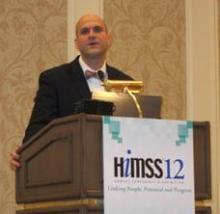UPDATED Feb. 24 to include information publication of the proposed federal regulations.
LAS VEGAS – Proposed stage 2 federal regulations for the meaningful use of electronic health records will require more effort from health care providers, but also promises to provide them with more flexibility.
"The main message is that we’ve stayed the course," Dr. Farzad Mostashari, national coordinator for health information technology, said at the HIMSS12 annual conference, where the regulations were previewed.
Much of what providers will see in stage 2 will be familiar because Dr. Mostashari’s organization, the Office of the National Coordinator for Health Information Technology (ONC), largely adopted the recommendations of the health information technology policy and standards advisory committees, he said.
The proposed regulation were published late in the day Feb. 23 in the Federal Register; comments must be filed by 5 pm ET on Apr. 23. Stage 2 of the meaningful use program will not start, however, until January 2014 for physicians and other eligible health care providers, and October 2013 for hospitals.
The proposed regulation has been sent to the Office of the Federal Register and should be published officially within days. Once published, the clock will start ticking on a 60-day public comment period. Stage 2 of the meaningful use program will not start, however, until January 2014 for physicians and other eligible health care providers, and October 2013 for hospitals.
There is a big push in the stage 2 regulations toward standards-based data exchange and interoperability, Dr. Mostashari said.
"We can’t wait 5 years to get standards-based exchange in this world," he added.
Specifically, in order to receive the federal incentive payment under Medicare or Medicaid, meaningful users will be required to use direct project protocols for secure e-mail, although they can instead opt for information-exchange certification through the SOAP (simple object access protocol) approach. For the first time, there is a single standard for transferring laboratory results, as well as messaging standards for public health, and standards for vocabulary.
To demonstrate compliance with data exchange requirements in stage 2, meaningful users will have to actually exchange data across organizational or vendor boundaries; a test exchange will not suffice, Dr. Mostashari emphasized. To that end, a summary of care must be sent to a recipient outside the meaningful user’s organization for more than 10% of referrals and transitions of care.
Under the proposed regulations, stage 2 also will put more emphasis on patient engagement. For physicians, it will no longer be enough merely to provide patients with access to their EHRs. At least 10% will have to access, download, or transmit the information to a third party. Also, more than half of patients must be provided with access to a summary of their treatment within 4 days.
Overall, the stage 2 regulations propose 17 core objectives plus 3 of 5 new menu objectives for eligible health care providers, and 16 core objectives plus 2 of 4 new menu items for hospitals. One menu objective includes the proposal that more than 40% of diagnostic medical scans and images be accessible through certified EHR technology, Centers for Medicare and Medicaid Services policy analyst Travis Broome said at the meeting. The electronic reporting of data to a cancer or specialty registry is also a new menu item.
Although stage 2 will further improve the meaningful use of EHRs, Dr. Mostashari said that the ONC also takes very seriously President Obama’s executive order that government agencies reduce regulatory burdens.
"In many parts, throughout both [regulations], we have done whatever we can to increase the flexibility and to reduce the burdens of these regulations," he said.
For example, the proposed rules allow group reporting of quality measures within a practice, instead of just individual reporting by physicians. Also, physicians and other health care providers can meet meaningful use requirements by using a complete EHR, a modular EHR, or a combination of modular EHRs.
Uptake of EHR technology has been good, but in an effort to further spur adoption, the Department of Health and Human Services announced last December that physicians who started efforts to participate in the Medicare EHR incentive program in 2011 would not have to meet stage 2 requirements until 2014, a full year later than originally planned.
"If there’s one thing that we’ve all learned, it’s that to truly make meaningful use of meaningful use, it takes time," Dr. Mostashari said.
He reported no conflicts of interest.


